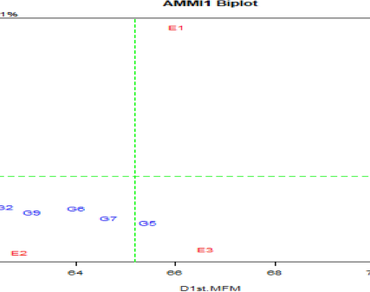Adaptability and stability analyses of long brinjal genotypes using AMMI model and genotype-by-environment (GGE)-biplot techniques
*Article not assigned to an issue yet
Research Articles | Published: 22 March, 2025
First Page: 0
Last Page: 0
Views: 507
Keywords: Brinjal (Solanum melongena. L), GxE interaction, ANOVA, AMMI, GGE biplot, Stability
Abstract
The genetic diversity of brinjal genotypes holds the key to greater resilience under increasingly unpredictable weather conditions. A field experiment was conducted to identify suitable genotypes for each environment to access climate-resilient genotypes to be planted under central Indian conditions. Nine brinjal genotypes were evaluated under three environments depicting three years, 2017–18, 1018–19, and 2019–20, and they were laid in a randomized complete block design to evaluate adaptability and stability. The well-graded, large, dark-colored fruits were selected, and they were then analysed using the AMMI (additive main effect and multiplicative interaction) model and the GGE (genotype plus genotype by environment) biplot. The principal component axes (IPCA 1) contributed 93.1% genotype x environment variation for days to first fruit maturity. The IVBL-25 genotype was relatively stable, with its mean value above the grand mean as per AMMI model. Similarly, NDB White-1 and Kashitaru were identified as stable genotypes at maturity under one environment. The DBL-60, DBL-17, and PBL-235 genotypes were stable under different environments using GGE biplot analysis. Cultivar-superiority measure, AMMI model, and GGE biplots were useful in assessing brinjal genotypes’ stability and adaptation under various environmental situations.

References
Adamczewska-sowińska K, Krygier M (2013) Yield quantity and quality of field cultivated eggplant in relation to its cultivar and the degree of fruit maturity. Acta Scientiarum Polonorum-Hortorum Cultus 12:13–23
Agricultural Statistics at a glance (2022) Economics and statistics division. Ministry of Agriculture and Farmer’s Welfare, p 92
APEDA (2022) Indian production of brinjal of 2021-22. Available at website aswww.apeda.in
Badu-Apraku B, Oyekunle M, Obeng-Antwi K, Osuman AS, Ado SG, Coulibay N, Yallou CG, Abdulai M, Boakyewaa GA, Didjeira A (2012) Performance of extra-early maize cultivars based on GGE biplots and AMMI analysis. J Agric Sci 150:473–483
Bora L, Singh YV, Kumar BB (2011) Stability for fruit yield and yield contributing traits in brinjal. Veg Sci 32:120–122
Bose LK, Jambhulkar NN, Pande K, Singh ON (2013) Use of AMMI and other stability statistics in the simultaneous selection of rice genotypes for yield and stability under direct-seeded conditions. Chile J Agric Res 74(1):3–9
Chaurasia SNS, Singh M, Rai M (2005) Stability analysis for growth and yield attributes in brinjal. Veg Sci 32:120–122
Ebdon JS, Gauch HG (2002) Additive main effects and multiplicative interaction analysis of national turfgrass performance trials. Crop Sci 42:497–506
Eberhart SA, Russel WA (1966) Stability parameters for comparing varieties. Crop Sci 6:36–40
Gauch HG (2006) Statistical analysis of yield trials by AMMI and GGE. Crop Sci 46:1488–1500
IPCC (2022) Intergovernmental Panelon Climate Change, WMO, Geneva, Switzerland. Available at ipcc.ch/report
Kang MS (1993) Simultaneous selection for yield and stability in crop performance trials: consequences for growers. Agr J 85:754–757
Kaya Y, Akcura M, Taner S (2006) GGE-biplot analysis of multi-environment yield trials in bread wheat. Turk J Agric Forestry 30:325–337
Koundinya AVV, Pandit MK, Ramesh D, Mishra P (2019) Phenotypic stability of eggplant for yield and quality through AMMI, GGE and cluster analyses. Sci Hort 247:216–223
Purchase JL, Hatting H, Deventer CS (2000) Genotype × environment interaction of winter wheat (Triticum aestivum L.) in South Africa: Π. Stability analysis of yield performance. South Afr J Plt Soil 17:101–107
Ranga AD, Darvhanker MS (2022) Genotype x environment interaction for fruit yield in Okra (Abelmoschus esculentus L.). Vegetos. https://doi.org/10.1007/s42535-022-00456-6
Thangavel P, Anandan A, Eswaran R (2011) AMMI analysis to comprehend genotype-by-environment (G x E) interactions to rainfed grown mungbean. Aust J Crop Sci 5:1767–1775
Yan W (2002) Singular value partitioning in biplot analysis of multi-environment trial data. Agron J 94:990–996
Yan M, Kang W (2003) GGE biplot analysis: a graphical tool for breeders, geneticists, and agronomists. CRC, Boca Raton
Yan W, Holland KJB (2010) A heritability-adjusted GGE bi-plot for test environment evaluation. Euphyt 171:355–369
Yan W, Hunt LA, Sheng Q, Szlavnics Z (2000) Cultivar evaluation and mega-environment investigation based on GGE biplots. Crop Sci 40:597–605
Zobel RW, Wright MJ, Gauch HG Jr (1988) Statistical analysis of a yield trial. Agron J 80:388–393
Author Information
Department of Plant Breeding and Genetics College of Agriculture, Jawaharlal Nehru Krishi Vishwa Vidyalaya, Jabalpur, India